Puerto Varas, Chile
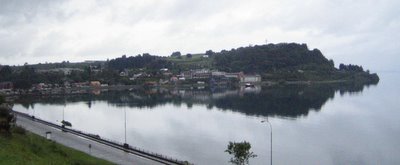
Visited November 23 and 24, 2005

On the banks of Lake Llanquihue (Chile’s largest and South America’s second largest lake) stands Puerto Varas: Founded by Germans in the 1850s, Puerto Varas started life as a commercial port shuffling through the lumber harvest; but it has been resurrected as a bedroom suburb for Puerto Montt (15 minutes away) as well as a hub for the great outdoors recreation (fly fishing, white water rafting, kayaking) in the area. If none of that appeals to you, there’s also a casino (first built as the grand hotel to kick off the tourism boom in 1934).
First Geography…

But first, a geography lesson. Check out the map (if it’s too small, click on it -- the more you click, the bigger it gets until it becomes actual size). To the west is, of course, the Pacific with direct connection to Puerto Montt, explaining how that ocean liner got there. The big island to the south is Chiloe formed by Chile’s coastal mountain range which ducked underwater but emerges again here. Puerto Varas is 12 miles north of Puerto Montt, crouching at the bottom of Lake Llanquihue (pronounced “yan-kee-way” –in Texas, we call that “walkin.”) To the east are a string of glacier-fed lakes which somehow cross the Andes into Argentina (the famous Lake Crossing which we’ll discuss in our next blog). A railroad connects Puerto Varas with its gritty southern neighbor Puerto Montt (and, of course, the Pacific).
…then Geology
On a clear afternoon, you can see eastward thirty-five miles across the lake to the Osorno Volcano – which fortunately didn’t erupt while we were there (nor since 1869). Unfortunately, it also wasn’t clear enough to see Mt. Osorno. Here’s a picture we didn’t take:
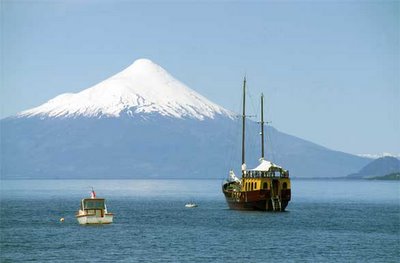
Volcano Osorno is a remnant of the geological upheaval that moved the Andes away from the coastal range when the South American tectonic plate overrode the Pacific plate (still, like the rest of us, a work in progress). Lakes such as Llanquihue were formed by the melting glaciers and can be nearly a mile deep.
Sharing our dirty linen

After arriving at our hotel from our flight from Santiago, we strolled through town toting our laundry bags to the local cleaners. Rain somewhat dampened our walk through the lovely square flanked by gypsy wagons, and roses. Here’s the type of fauna that peered out at us from nearly everwhere:
A walk in the Parque
The next day, after a leisurely lunch at a guide-book restaurant complete with its red-haired German chef (enough local color for you?) Jane and I took a vigorous walk up the town's tallest hill which sports a large cross courtesy of the local Lions club (see photo above). The cross stands atop Parque Philipi.
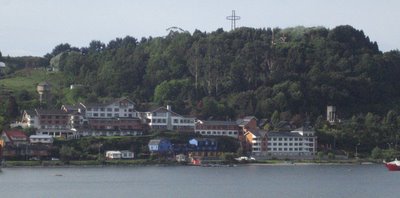
On our way up, we were accompanied by one of the omnipresent Chilean stray dogs who immediately detected a sucker for canines.

After a few minutes, we reached the summit in Parque Philipi and its cross:
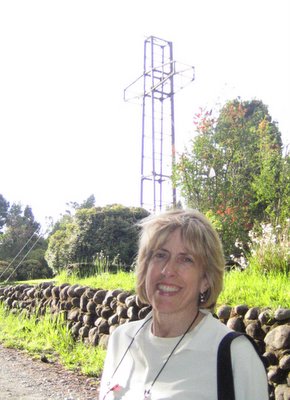
Close-up, the cross is nowhere near as dramatic as when seen from a distance, especially when lit at night (see the last picture). Jane, however, is every bit as dramatic, if not more so.
But the vantage provided great views of Puerto Varas. Here’s one looking over our hotel (center in the picture below)…

…and over the rest of the town with the oaken church of the Sacred Heart (Parroquia del Sagrado Corazon. de Jesús) at center right. This building was based on a church in Germany’s Black Forest.
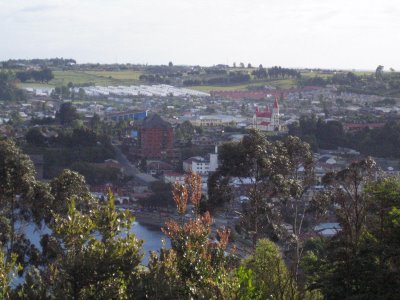
About town
After leaving Parque Philipi, we attempted to follow the Frommer’s guidebook walking tour to see some of the buildings. Puerto Varas sports the best mid-European architecture in Chile, primarily 19th century vintage German homes like this one:
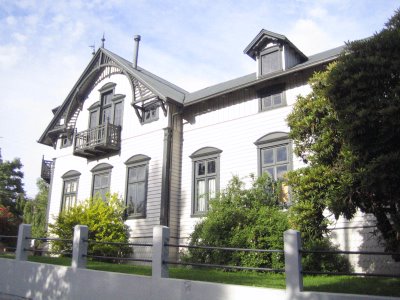
Eight of these homes have been declared national monuments; typically they were built between 1910 and 1940. We followed the path laid out by the guidebook but couldn’t find many markings to help us find the monumental houses. If you’re interested in that sort of thing, click here.
How does your garden grow?

Puerto Varas is a lush place (at least for gardens, we can’t speak for booze, but given Chilean wines, suspect that as well). Our lunch table overlooked the kind of garden you find in this part of Chile, including the Monkey Puzzle Tree you see here. This Conifer can grow several hundred feet high and was named by an Englishman who thought it would be a puzzle for a monkey to climb. Fossil evidence shows the species has been around 60 million years. Its seeds (which start coming after about 40 years – even slower than humans) were a staple of the indigenous people of the area (the Mapuches). The tree loves well drained volcanic soil, so its found its home in this location (although we saw Monkey Puzzle Trees in Santiago, as well.
Here’s another garden picture, this one outside group of artisan boutiques forming a quiet square just off the casino strip.
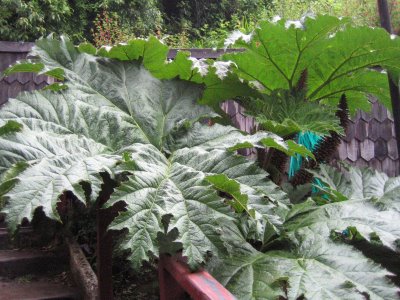
We went to sleep with this harbor view of Puerto Varas and its cross high up on Parque Philipi. The next day we were up early to cross the Andes by water. Stay tuned!
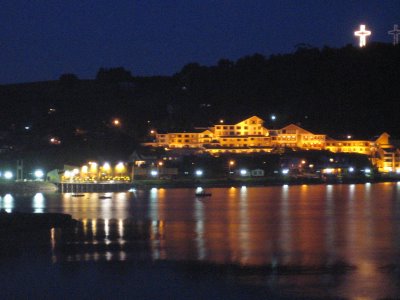
-------------------------------------------------------------------------------
Typical bottom-of-the-blog stuff
Internet Explorer users, want to see more? Then download the Firefox browser by clicking here – these pages work better in it and its more secure.
Where are we now?
Click here for an interactive map of Chile.
-------------------------------------------------------------------------------
Labels: vacation travel
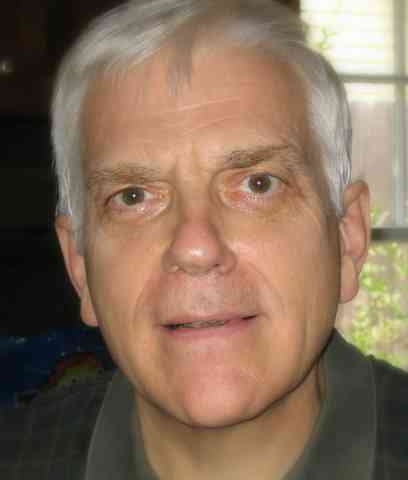

0 Comments:
Post a Comment
<< Home